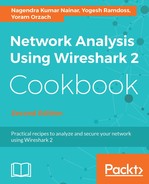When fragmentation takes place, you will see UDP or TCP packets along with fragmented IP protocol packets, as shown in the following screenshot:

If suspecting performance problems, for example, a database client that experiences slow connectivity with the server, follow these steps to see whether the problem is due to fragmentation:
- Test the connectivity between clients and the server to verify that there are no other problems.
- Look for fragmentation between the client and the server. Fragments will be shown as in the previous screenshot (IPv4 fragments).
- In the case that you suspect fragmentation to be the reason for the problem, it can be rectified either by fixing the MTU of the transit path or by tweaking the application to send smaller packets that do not cause fragmentation to the network.
- The recommended packet size in Ethernet is not greater than 1460 bytes minus the TCP header size. Thus, the segments coming out of the interface should have a size of 1420-1440 bytes.
In cases where we need more bytes for the header, for example, when we use tunneling mechanisms and TCP options, the DBA will have to reduce this size even more. The best way will be simply to reduce it to such a size that you will not see any fragments.
